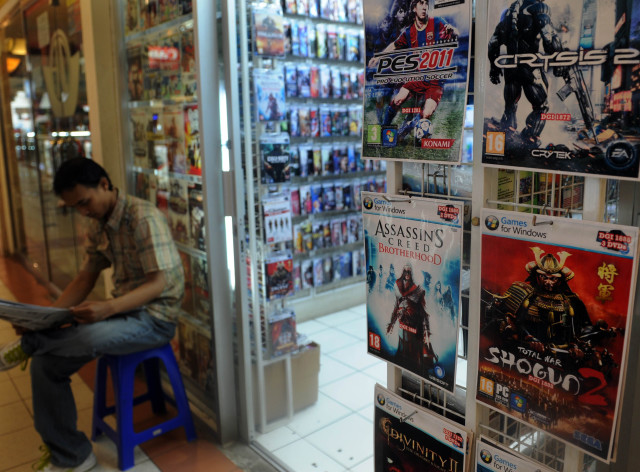
Pirated software is displayed at a shop in Jakarta, Indonesia on May 12, 2011. (AFP)
Piracy accounts for 43 percent of all software installed on PCs, or about $62.7 billion in commercial value, according to BSA | The Software Alliance 2013 figures. And while developers have been using Digital Rights Management (DRM) tools to thwart pirates, some have taken a less-traveled anti-piracy path.
Among them is Croteam, an independent game developer in Croatia that turns the dynamics of a given game against the crooks that pirated it.
Croteam CTO Alen Ladavac describes some of the tactics his company uses to fight off pirates in an email interview with TECHtonics.
Q. Do your unconventional anti-piracy methods forgo DRM?
Ladavac: … This still uses DRM. With methods like this, you need to detect whether the player owns the game or not, and if not the so-called “trigger” is activated and does things like “stuck in the elevator,” or “immortal pink scorpion” – a monster that is impossible to kill that goes after pirates’ characters.
Well played, @Croteam. Well played. http://t.co/jHO3BiQoPN pic.twitter.com/UYfYXPlbrH
— Devolver Digital (@devolverdigital) December 28, 2014
To determine whether the game is legally owned, a DRM system is used. However, in this case, it doesn’t bother legit players because the underlying DRM used is Steam, which is basically friendly towards the players, so people see more benefit than problems in using Steam.
Q. How does this work exactly? Is this a way to out the pirates and put them to shame?
Ladavac: Our goal is not to shame pirates, but to deter them from using the pirated versions and promote being legit.
One of the most important things for us is that the legit buyers feel like they are being honored. If we didn’t put any anti-piracy measures, they could say that we don’t really care whether someone pirates the game and could feel like they are being “cheated,” as they paid for something that others are just copying away.
… Customer feedback shows that they really appreciate it that the anti-piracy triggers are in, as they like to know that those that don’t pay can expect to have problems.
… A lot of avid gamers like to actively support developers of the games that they like. They know that if they pay for the games, they will get more games that they like, whereas if no one paid, there would be no games. In that light, they too like to see that something is being actively done to deter those who are undermining the foundations of such a positive feedback loop.
PC players! If you’re online complaining about the lack of FOV control … You pirated the game.
— Alex Hutchinson (@BangBangClick) November 18, 2014
Q. Are any other developers taking this path to counter piracy?
Ladavac: … This method has been used by numerous other developers. Most popular recently were: Batman Arkham Asylum, where pirates were unable to perform some flying moves [and] couldn’t progress; Far Cry 4 removed the FOV slider from the options; Alan Wake put an eyepatch on the player character, making it impossible to take screenshots without telling the world that they are pirates, and, of course, we have to mention GameDev Tycoon, where the pirated version made the players face insurmountable piracy problems.
Q. Has this approach been successful?
Ladavac: The most important thing to know is that it is not possible to make a protection that is entirely uncrackable. That’s the biggest limitation with all anti-piracy solutions. You can only hope to keep them at bay for as long as possible. With enough effort they will eventually crack it, this way or another. Then we change or improve the method for the next title, and the process repeats.
The … most important period for a game is the first few weeks or months after the release. If you can keep it protected during that period, you have achieved a lot.
… We used a similar approach on four games so far. One was more than 20 years ago, on Football Glory for Amiga (1993). That one was never cracked, to our knowledge. But, unfortunately the underlying DRM at that time was “input a code from page X in the manual to prove you are the owner.” So the pirates ended up distributing the list of all codes with the pirated version.
More recently, for Serious Sam HD: The Second Encounter (2010), it took the pirates six months to crack it. With Serious Sam 3: BFE (2011), [the] first crack was the famous immortal pink scorpion, and it took about 3 weeks until it was removed and several more months until the last of the remaining triggers were removed.
For The Talos Principle (2014), we are still not aware of any real functioning cracks. There are some strange ways to make the pirated game work on some machines, but it is not a simple crack that a non-technical user could install.
According to that, I’d say it is working.

One response to “Help! I’m a Pirate and I’m Stuck in the Game!”
In fact in China, without piracy, netizens even couldn’t know these games in such closed network environment. So piracy improves these games reputation in a way.A small part of players play singleplayer mode of the pirated games first and then share or buy it for multiplayer mode.In this way, customers in China bought more Battlefield than Call of Duty.Free online games which charge for virtual equipment are everywhere in China, but these suit Chinese market the most and earn the most.